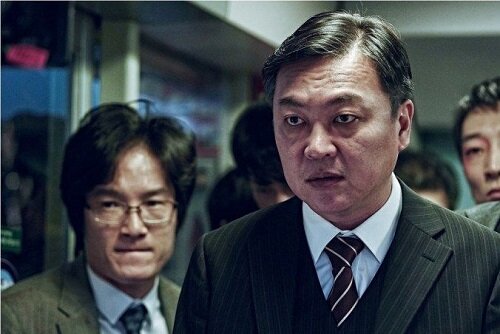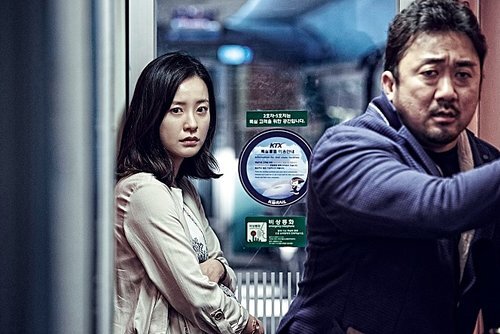Film Review - 'Train to Busan'
Known for his feature-length animated films, ‘Train to Busan’ is director Yeon Sang-ho’s first live-action film.
The only other Korean programme I’ve watched is the excellent ‘Kingdom’. Coincidentally, they’re both zombie films. As with ‘Kingdom’, none of the actors in ‘Train to Busan’ are familiar to me although, obviously, they’re well-known in their home country.
The film opens with a pig farmer’s truck approaching a roadblock, patrolled by people in full Hazmat suits. He wants to know if there’s been another outbreak but is reassured it’s nothing of that sort. He berates one of the men, saying he can’t afford to lose any more of his livestock like the last time.
He drives on, the road ahead of him deserted. While reaching for his phone, he momentarily looks away and hits a deer. Annoyed, he drives on. Which means, he doesn’t see the deer spasm, flip itself over and jerkily get to its feet.
In Seoul, we’re introduced to Seok-woo, played by Gong Yoo, a fund manager who’s clearly married to his job.
Seok-woo (Gong Yoo)
Arriving home, he’s on the phone with his estranged wife and its obvious things aren’t well between them as they argue about their young daughter. We’re not told the reason, but his daughter lives with him and she’s looked after by Seok-woo’s mum who also lives with them.
Su-an, his daughter, played by Kim Su-an, is an unhappy little girl, and the scene with father and daughter highlights their strained relationship.
Su-an (Kim Su-an)
After flubbing her birthday present, he tells her she can have whatever she wants for her birthday.
She wants to go to Busan to spend the day with her mother. When he says he’s too busy and will take her another day, she insists she’s able to go on her own.
In the early hours of the following morning, Seok-woo takes Su-an to the train station for their journey to Busan.
As they take their seats on the train, Seok-woo is on the phone to his subordinate, telling him he’ll be back at the office that afternoon.
In the same carriage as Seok-woo and Su-an are two older women; Jong-gil, played by Park Myung-sin, and her older sister, In-gil, played by Ye Soo-jung.
Jong-gil (Park Myung-sin)
In-gil (Ye Soo-jung)
Taking up another carriage is a school baseball team, who are thrilled when the head cheerleader, Jin-hee, played by Sohee, joins them. She makes a beeline for a young man who’s hunkered down in his seat with his headphones on.
Yong-guk, played by Choi Woo-shik, tells her to sit elsewhere before resigning himself to the good-natured ribbing of his teammates.
Jin-hee (Sohee) and Yong-guk, in baseball cap (Choi Woo-shik)
Just as the train is about to depart, a young woman jumps on board. The guard, his back to her, doesn’t notice as he signals the ‘all-clear’ to the driver.
The train leaves and, as he walks to the stairs leading up to the main part of the station, the guard looks up and pauses, wondering what’s causing such an agitated scene.
As the train picks up speed, Su-an, looking out her window, glimpses a running figure who appears to jump on someone. She turns to tell her father, but he’s fallen asleep.
The young woman who’d jumped on the train has locked herself in the toilet and is tearfully, shakily trying to bandage her bleeding leg.
Another passenger, Yong-suk, played by Kim Eui-sung, a rich company man, alerts one of the stewards that he believes someone is in the toilet who shouldn’t be there.
Yong-suk (Kim Eui-sung)
Overhearing them, a curious Su-an leaves her seat to get a closer look.
Cowering inside the toilet is a homeless man, played by Choi Gwi-hwa, muttering to himself.
Homeless man (Choi Gwi-hwa)
The steward ushers Su-an on so he can deal with the man.
She wanders off and encounters Sang-hwa, played by Ma Dong-seok, a blue-collar man who comes across as a bit of a tough guy. He stops her knocking on the door of the toilet, telling her its occupied, and shoos her along.
We later meet the person who is in the toilet – Seong-kyeong, played by Jung Yu-mi, Sang-hwa’s wife who’s pregnant with their first child. He dotes on her and treats her with great care. His habit of tactlessly speaking his mind, much to the consternation of Seong-kyeong, makes for some amusing moments.
Seong-kyeong (Jung Yu-mi) and Sang-hwa (Ma Dong-seok)
In this way, we’re introduced to the main characters in the lull before the growing storm.
The young woman who’d jumped on the train is found by one of the stewardesses. Believing the young woman to be ill, she tries to help the unfortunate soul who’s on the ground, spasming. The stewardess radios through to one of her colleagues for help. When her radio falls silent, he runs to help her. And some of the more aware passengers begin to suspect something is not quite right.
Coming awake, Seok-woo realises Su-an isn’t in her seat and goes to find her.
The zombie storm breaks in the carriage with the baseball team as the stewardess desperately tries to get the zombie woman off her.
Interestingly, the tv screens in each carriage are showing chaotic scenes in the major cities. The newsreaders are calling it civil unrest and telling people to remain calm as there’s nothing to worry about and the government has everything under control. This adds to the growing sense of unease on the train.
The action, once it starts, is more or less nonstop. Setting the film in the narrow confines of train cars gives it an uncomfortably claustrophobic feel.
I don’t know if this is the norm for Korean zombies but, as in ‘Kingdom’, these creatures don’t shamble along, giving you a chance to get away. These things are fast. And I mean, unbelievably fast despite the highly unsettling herky-jerky way they move.
When they become infected, their bodies contort painfully and their limbs snap in such a way as to appear broken.
The undead in ‘Train to Busan’ don’t take the time to chow down on their victim, which usually gives survivors a good chance of getting away. Instead, they take a couple of chomps before racing to tear a bite out of their next victim. This increases their numbers at a crazy speed, which means the outbreak is sweeping across the country too fast to be contained.
The different camera angles – sweeping shots of empty stations and distant views of ravaged cities to shaky close-ups of terrified people and hungry zombies – is enhanced by the music. Yet there are also scenes with no music, only dialogue and sound effects. When the music starts up again, matching the action, it only serves to heighten the tension.
There is one scene, deftly handled, which is played out almost silently and so slowly, it had me holding my breath. Juxtapose that with a rare scene where the passengers leave the train and the chaotic scenes that follow are true edge-of-the-seat stuff.
Of course, none of this would amount to anything if the characters were badly written and uninspiring.
No worries there.
Seok-woo’s change from a self-absorbed man who thinks nothing about leaving others behind to save himself and his child to one who’s willing to do what it takes to help others is convincing. And I found the evolving relationship between him and Su-an, touching.
Sang-hwa is solidly dependable and not afraid to step up when the situation demands it. Seong-kyeong, despite being pregnant, isn’t a damsel-in-distress looking to others to protect her. Without making a big deal of it, she also looks out for Su-an.
I found both the teenagers, Yong-guk and Jin-hee, likeable with good heads on their shoulders.
There’s one character who turns out to be quietly heroic – the train driver, played by Jeong Seok-yong.
The train driver (Jeong Seok-yong)
The character who fast became my favourite is Su-an. Kim Su-an is an amazing actress despite her age. I think she was about 10 when this was filmed and, at no point, did I find her annoying. Usually, I’m wary of child actors as there’s usually some aspect of them that grates. Not so this young lady. Her reactions are very believable and the scenes showing her beside herself with terror or when she’s greatly upset are truly heart-rending.
I learnt my lesson with ‘Kingdom’ – apologies for the constant comparisons – it doesn’t matter where the actor’s name features in the credits or how popular they are, there is no guarantee as to who will survive and who will fall. Which meant I was truly worried for the characters. I genuinely cared for them and didn’t want any of them to die. Except for one who, as awful as this sounds, deserved it.
One gripe I have – and it’s a minor one – is the rate at which people turn. It takes some time for the first infected person, the young woman, to turn. Yet, with her first victim, the stewardess, the change is almost immediate, as is the case with each subsequent victim. The gradual change the first time we see it does add to the tension so maybe that’s the reason. At the end of the day, it didn’t diminish my enjoyment of the film.
A quick aside – to add to the realism of the limb-snapping, jerky movement of the zombies, the actors who portrayed the creatures were trained for about 6 months by professional dance artists who specialise in zombie-like movement.
And the make-up artists didn’t simply cover the ‘zombies’ in blood; they applied dark lines across their faces and skin, mimicking veins distorted by infection.
Some people may be put off by the fact it’s in Korean, but I don’t mind watching a subbed film; most times, I prefer watching a foreign film in the original language. It didn’t lessen the horror element for me at all.
Obviously, this is by no means a perfect film. There’s at least one plot point that seemed unnecessary and its inclusion felt clumsy. But I enjoyed it more than I thought I would and plan to watch it again.
If you love the zombie genre and haven’t watched ‘Train to Busan’ yet, I highly recommend it.









